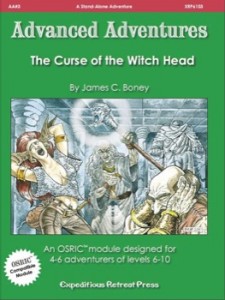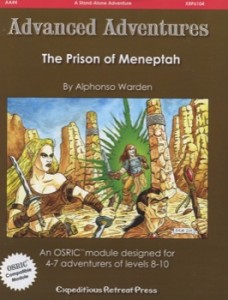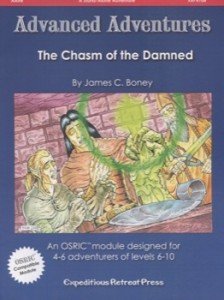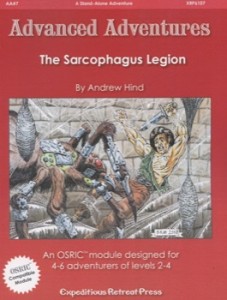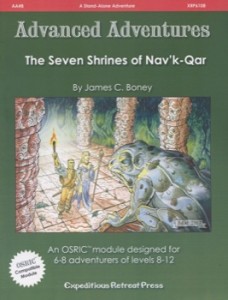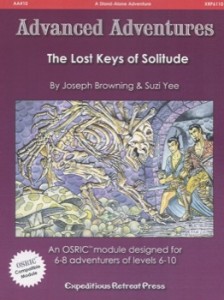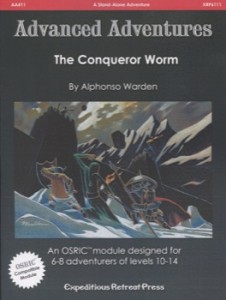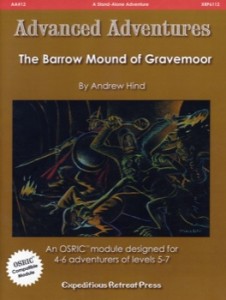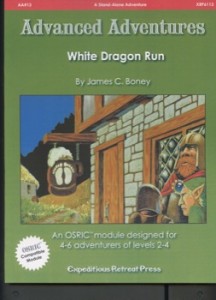In a time long ago a local noble family rose to power through the use of an evil artifact: The Witch’s Head. Eventually a good member of the line came to power and buried the head in a dungeon, protecting it with traps. Recently that same family is now being threatened: send money and your teenage daughter or the bad guy will turn loose the power of the head once more! The party is summoned and sent to root out the evildoers. Oh yeah … a local contingent of the lords troops, as well as two other adventuring parties ,have not returned from the same quest …
This module starts out strong in two ways. First, we have an immediate gruesome artifact in play, the Witch Head. It’s an actual head with evil powers. That’s a pretty cool item. Second, we get a good dose of foreshadowing: the last three attempts have failed. There’s no overland adventure however there is another good piece of foreshadowing right outside the dungeon: 23 bodies crucified on oak X’s surrounding Witcheed Hill. Not only does this further build tension, but we also get a little dose of name evolution in the hills name. I like both of these elements, it gives a sense of continuity to the adventure; things have happened in the past and the party is seeing the results right now. The build-up to the villains could be a little stronger, but it’s much better than poor old Lareth in T1. For a villain to be truly effective you need some build up to him, and the intro to this scenario does this more than a little.
The dungeon proper is interesting. While it was once a real dungeon to house and protect the head, it’s been broken in to by our villain and partially cleared and is now where he’s operating out of. Thus we get some aspects of the dungeon in their native form, some with the new villain, and some that are a mix as the new guys beef up or leave traces of their coming & goings. Again, this presents the dungeon in a living and breathing manner, rather than as a static location where things never change. There are only about 20 keyed encounters on the map. It has a couple of loops on it, however it’s too small to be a truly interesting map. There are lots of weird shaped rooms and a lake though, and I still found it’s layout interesting.
There are several very nice tricks and traps. Braziers that can be lit for effects, a desecrated temple where good & evil vie with each other, crumbling floors, and so on. I really enjoyed how these were presented. The old ‘desecrated temple’ bit is presented nicely: the room impacts both good & evil characters in strange ways, and a boon is gained if the temple is cleansed of the desecration. There are a couple of other interesting traps also: the crumbling floor for example, and a Wand of Illumination/Magic Mouth/prism room trap that I found interesting. The creatures are a good selection, a few new undead, a few old undead, constructs, and an NPC party of bad guys. There are a few vermin & such around the lake also. I found the monster population made sense, especially in the context of the new guys moving in and setting up shop.
Several new magic items are presented, in addition to the Witch Head relic. The Staff of Screams has a great name and effect, and the Dust of Distortion is a nice new item also. They both lend to the feeling of weird fantasy that I like in my games. Staff of Soundburst? Screw That, I want a Staff of Screams! We also get about three pages of new monsters. I like new monsters in my adventures; the party never knows what to expect when they encounter one and it scares the daylights out of them!
The module is short. Only about five pages describe the dungeon, with the second half be given over to the new monsters, magic items, and NPC party (which should hound the party throughout their crawl.) It packs a lot in to those pages though, and would be a great little adventure to run for an evening or two. I approve.
This is available on DriveThru.

